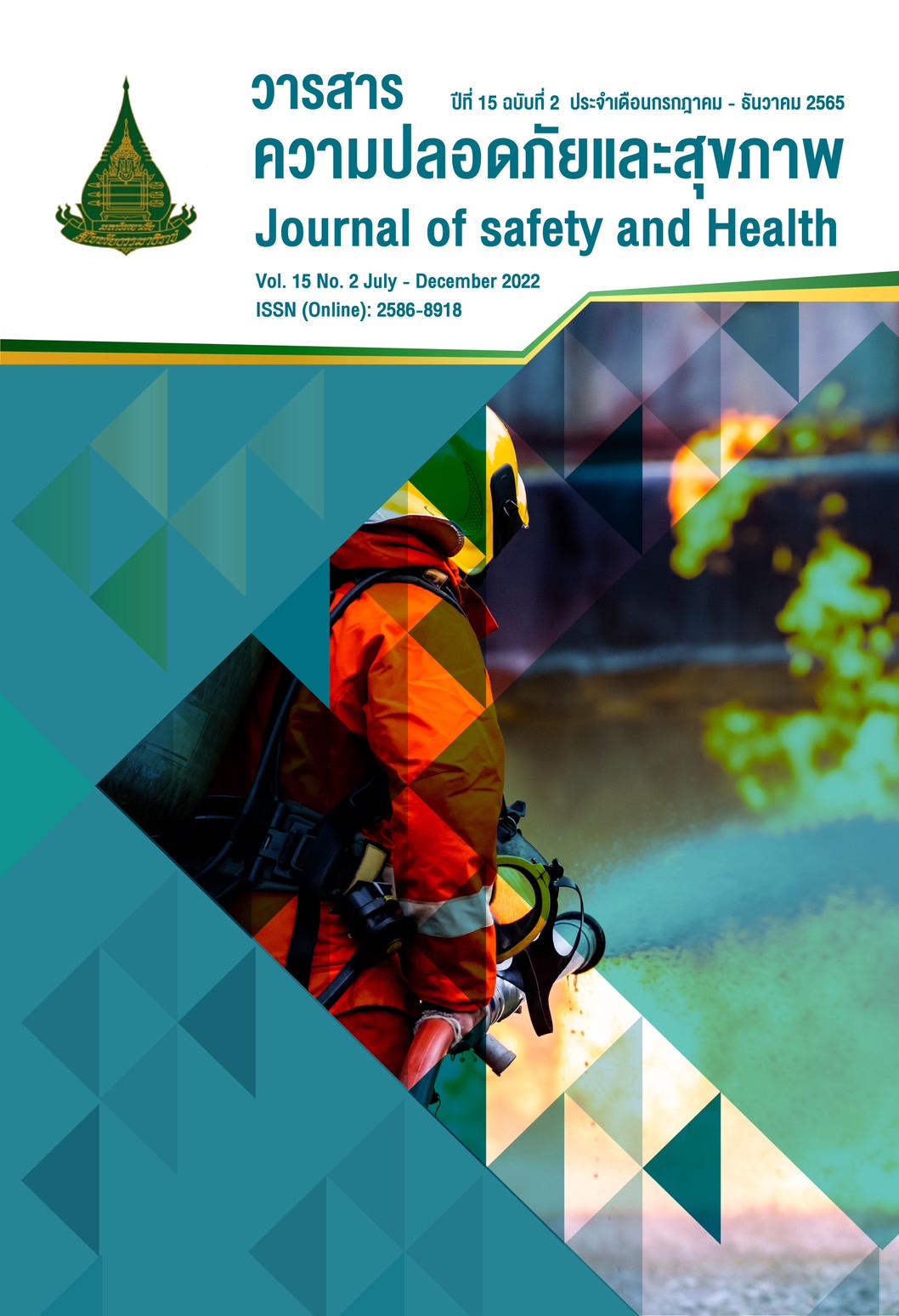Health risk assessment of lead, cadmium, arsenic from the consumption of rice in Watsing District, Chainat Province
Main Article Content
Abstract
This research aims to analyze the quantity of heavy metals – lead, cadmium and arsenic which are contaminated in rice and to assess health risk from rice consumption contaminated with heavy metals for farmers and rice consumers. The populations involved in the study were 30 farmers in Don Tan, Nong Noi, Wat Sing, Chainat. They consumed Hom Pathum from two rice field samples which were cultivated in such area. Data sources were collected from interviews and questionnaires. The results showed that the contamination of arsenic in rice was detected. Nevertheless, to assess the arsenic exposure, the lifetime cancer risk (LCR) was calculated using the estimated daily intake (EDI) individually. Health risk assessment of rice which was contaminated with arsenic indicated that the minimum EDI was 0.41 mg/kg and the maximum value was 0.02349 mg/kg. These values do not exceed the standard for arsenic contamination in Thai rice, which is 2 mg/kg. However, the LCR was between 0.00062 – 0.03542, which was over 0.0001. The assessment result reveals that this level is not safe for rice consumers.
Article Details

This work is licensed under a Creative Commons Attribution-NonCommercial-NoDerivatives 4.0 International License.
Journal of Safety and Health is licensed under a Creative Commons Attribution-NonCommercial-NoDerivatives 4.0 International (CC BY-NC-ND 4.0) licence, unless otherwise stated.
References
กองโรคจากการประกอบอาชีพและสิ่งแวดล้อม. (2562). ความรู้เรื่องโรค. กรมควบคุมโรค. http://envocc.ddc.moph.go.th/
กัญญ์กุลณัช คำปวง, พลยุทธ ศุขสมิต, สมชัย ลาภอนันต์นพคุณ, ยุทธ์ดนัย ยอดทองดี, และ ชนากานต์ เทโบลต์ พรมอุทัย. (2559). การตอบสนองของผลผลิตในข้าว 3 พันธุ์ที่ปลูกในดินที่มีปริมาณแคดเมียมแตกต่างกัน. แก่นเกษตร, 44(3), 409-416.
เกวลิน รอดขวัญ, วัชรี รวยรื่น, และ นรานันท์ ขำมณี. (2563). การปนเปื้อนของโลหะหนักในตะกอนดินบริเวณพื้นที่เพาะเลี้ยงหอยแครงและปากแม่น้ำท่าทอง อ่าวบ้านดอน จังหวัดสุราษฎร์ธานี. วารสารวิชาการวิทยาศาสตร์และเทคโนโลยี, 1(2), 41-57.
ธนิกา น้อยถนอม, จินตนาถ วงศ์ชวลิต, และ ธนวรรณ พาณิชพัฒน์. (2562). การกำจัดตะกั่วที่สะสมในต้นข้าว. วารสารวิทยาศาสตร์ มข., 47(3), 498-507.
เบญจภรณ์ ประภักดี และจิรวีฐ์ แสงทอง. (2559). แนวทางการฟื้นฟูพื้นที่ปนเปื้อนแคดเมียมด้วยวิธีที่เป็นมิตรต่อสิ่งแวดล้อมจากขวดทดลองสู่พื้นที่จริง. วารสารสิ่งแวดล้อม, 20(1), 1-13.
ประกาศกระทรวงสาธารณสุขฉบับที่ 414 พ.ศ. 2563. ออกตามความในพระราชบัญญัติอาหาร พ.ศ. 2522 เรื่อง มาตรฐานอาหารที่มีสารปนเปื้อน. (2563, 20 พฤษภาคม). ราชกิจานุเบกษา. เล่ม 137 ตอนพิเศษ 118 ง.
ปิยะดา วชิระวงศกร, สิรินรัตน์ รอดขาว, และ เจนจิรา ช่วยปุ่น. (2558). การประเมินความเสี่ยงต่อสุขภาพจากการบริโภคผักประเภทใบที่มีการปนเปื้อนสารตะกั่วและแคดเมียม: กรณีศึกษาเขตภาคเหนือตอนล่างของประเทศไทย. Rajabhat J. Sci. Humanit. Soc. Sci., 16(2), 167-177.
ธนภัทร ปลื้มพวก, จันทร์จรัส วีรสาร, อรุณศิริ กำลัง, และ ธงชัย มาลา. (2558). การปนเปื้อนแคดเมียมในดินและการสะสมในผลผลิตข้าวบนพื้นที่ตำบลแม่ตาวและตำบลพระธาตุผาแดงอำเภอแม่สอดจังหวัดตาก. วารสารเกษตรพระวรุณ, 12(1), 1-8.
ธีรนาถ สุวรรณเรือง. (2563). โลหะหนักปนเปื้อนในสิ่งแวดล้อมและผลกระทบต่อสุขภาพ. วารสารวิจัยและพัฒนาระบบสุขภาพ, 13(1), 76-82.
นุชจรี ท้ายสนิท และปิยะดา วชิระวงศกร. (2021). การประเมินการปนเปื้อนโลหะหนักบางชนิดในดินนาข้าวของจังหวัดสุโขทัย. PSRU Journal of Science and Technology, 6(1), 99-108.
นุชนาถ รังคดิลก, สุมลธา หนูคาบแก้ว, และ จุฑามาศ สัตยวิวัฒน์. (2562). งานวิจัยสารหนูในข้าวไทยเพื่อรองรับการกำหนดค่าสูงสุดของสารหนูในข้าวเพื่อการส่งออกข้าวไทย. วารสารวิชาการข้าว, 10(2), 101-116.
ภัทราวดี วัฒนสุนทร และจินตนา อมรสงวนสิน. (2559). การตรวจวิเคราะห์การตกค้างของสารกำจัดศัตรูพืชและสัตว์ในตัวอย่างดินจากนาข้าวในพื้นที่จังหวัดชัยนาถ. วารสารวิชาการมหาวิทยาลัยราชภัฎอุตรดิตถ์, 11(2), 246-258.
ลำใย ณีรัตนพันธุ์, สมศักดิ์ อินทมาต, Arthone Khammanichanh, และ มานพ ศรีอุทธา. (2558). ปริมาณสารหนูในข้าวเหนียวพันธุ์ กข 6 บริเวณเหมืองแร่ทองคำ. วารสารวิทยาศาสตร์คชสาส์น, 37(2), 11-25.
สายชล สุขญาณกิจ และธนวรรณ พาณิชพัฒน์. (2556). เปรียบเทียบการเจริญเติบโตและการสะสมตะกั่วของทานตะวันและข้าวฟ่างในดินที่ปนเปื้อนตะกั่ว. วารสารวิทยาศาสตร์ มข., 41(4), 996-1007.
Fanfu Z., Wei W., Mansha L., Ruixue H., Fei Y., & Yanying D.. (2015). Heavy Metal Contamination in Rice-Producing Soils of Hunan Province, China and Potential Health Risks. International Journal of Environmental Research and Public Health, 12(12), 15584-15593. https://doi.org/10.3390/ijerph121215005
Noelle L., Edmund S., Brenda E., May W., Yan L., & Jenna H.. (2018). A comprehensive review of arsenic exposure and risk from rice and a risk assessment among a cohort of adolescents in Kunming, China. International journal of environmental research and public health, 15, 2191.
Otero X. L., Tierra W., Atiaga O., Guanoluisa D., Nunes L. M., Ferreira T.O., & Ruales J. (2016). Arsenic in rice agrosystems (water, soil and rice plants) in Guayas and Los Ríos Provinces, Ecuador. Science of the total environment, 573, 778-787.
Chanpiwat P., & Woong-Kim K. (2019). Arsenic health risk assessment related to rice consumption behaviors in adults living in Northern Thailand. Springer Link. https://link.springer.com/article/10.1007/s10661-019-7836-y

